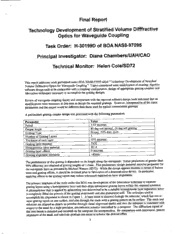Table Of ContentFinal Report
Technology Development of Stratified Volume Difffractive
Optics for Waveguide Coupling
Task Order: H-30199D of BOA NAS8-97095
Principal Investigator: Diana Chambers/UAHICAO
Technical Monitor: Helen ColelSD72
This report addresses work performed under BOA NAS8-97095 rifled "Technology Development of Stratified
Volume Diffractive Optics for Waveguide Coupling." Topics considered were modification of existing, rigorous
software design tools to be comparible with a coupling configuration, design of appropriate grating couplers and
fabrication techniques necessary to accomplish the grating designs.
Review of waveguide coupling theory and comparison with the rigorous software design tools indicated that no
modifications were necessary at this time to design the required gratings. However, interpretation of the input
parameters and the output would be different than those used for typical transmission gratings.
A preliminary grating coupler design was generated with the following parameters:
Parameter Value
Period 1.64 microns
Output Angle 80 deg wrt normal, 10 deg wrt grating
Grating T)lae Binary, 50% duty cycle
3
Number of Grating Layers
.075 microns
Thickness of each layer
Grating layer material TiO2
SU-8
Homogeneous layer material
0 microns
Grating layer offsets
--40nm
Grating alignment tolerance
The performance of this grating is dependent on its length along the waveguide. Initial predictions of greater than
98% efficiency are obtained of grating lengths of 1-2mm. This preliminary design assumed material properties for
the wavegnide layer as provided by Michael Watson (SD72). While the design appears feasible in terms of feature
sizes and grating offsets, it should be revisited prior to fabrication of a demonstration device. In particular,
applying offsets to the grating layers may reduce tolerances required on layer alignments.
The primary emphasis of the work under this BOA was development of the fabrication technique to separate
grating layers using a homogeneous layer and then align subsequent grating layers within the required tolerance.
A photopolymer that is applied by spincoating was determined to be a suitable homogeneous layer separation since
it completely filled the grooves of the grating underneath and also planarized well. The technique used to
accomplish the alignment is shown in Figure 1. A laser beam is directed through the substrate, which has one or
more grating layers on one surface, and also through the mask with a grating pattern on its surface. The mask and
substrate are aligned as closely as possible through visual alignment marks and then the substrate is translated with
respect to the mask by a high-precision, piezoelectric actuator controlled by a computer. The diffraction signal of
the laser beam is detected and recorded on the computer for interpretation. By comparison with simulation, precise
alignment of the mask and substrate gratings can occur to achieve the desired offset.
1
_ Intensity vs. Alignment Detector
Mask (grating)
'_--Substrate (grating)
ContrOller"
PZT Actuator Fiber-optic
cable
• Polarized
• Power Stabilized
• TE Cooled
Figure I. Alignment technique for multiple grating layers
The equipment necessary to implement this scheme hasbeen obtained in cooperation withfunding under a
cooperative agreement with GHCC. The equipment has been installed on a mask aligner at UAH and software has
been written to control its operation. Alignment has been attempted ona number of samples intended for
demonstration as a lidar scanning element. The progress for this isoutlined inFigure 2.
Ali.gqamentSummar x
• Offsetsapplied: 1.15- 1.85gm
• Toleranceachieved: +0.11am
Tolerance attempted: +0.1pm
• Approaches toachievingrequired
(0.03-0.04gin) tolerance:
- ImprovePZT'creep'
compensation
- Furthercharacterize systematic
bias duetomask aligner
- Refme alignmentalgorithm
Figure 2. Alignment status.
In conclusion, the technique of Stratified Volume Diffractive Optical Elements (SVDOE's) seems tobe feasible for
application towaveguide couplers. Preliminary design studies were conducted under this task, but further work
should be done prior tofabricating and testing any demonstration elements. The focus of this task has been
development and testing ofthe alignment technique, the most challenging aspect of SVDOE's, for achieving
precise alignment, including layer offsets, ofthe grating layers within SVDOE's. Progress on this aspect has been
very favorable with demonstrated tolerances that are much improved over standard diffractive optic alignment
techniques.
Form Approved
REPORT DOCUMENTATION PAGE
OMB No. 0704-0188
Pubtiorepot'ring burden forthis collectionofinformation isestimated toaverage 1hour perresponse, includingthetime forreviewing instruc_ons, sean:hing existing datasources, gathering
and maintaining the data needed, and completing and reMew_ngthe colles'don of information Send comments regarding this burden estimate orany other aspect of this colles'don of
information, including suggestions for reducing this burden, toWashington Headquarters Se_ces, Directorate for Inform_,ltionOperations and Reporl_, 1215 Jefferson Davis Highway, Suite
1204, Arlington, VA 22202-4302, andtothe Off_e ofManagement and Budget, Paperwork Reduction Project {0704-0188), Washington, DC20503.
• AGENCY USE ONLY (Leave b/ank) 2. REPORT DATE 3. REPORTTYPE AND DATES COVERED
5January 2000 Final2/26/99 - 9/39/99
5. FUNDING NUMBERS
4. TITLE AND SUBTITLE
Technology Development ofStratified Volume Diffractive Optics forWaveguide Coupling
6. AUTHORS C #NAS8-97095, TA #H-30199D
Diana M Chambers
7° PERFORMING ORGANIZATION NAME(S) AND ADDRESS(ES) 8. PERFORMING ORGANIZATION
REPORT NUMBER
University of Alabama in Huntsville
N/A
301 Sparkman Drive
Huntsville, AL 35899
9. SPONSORING/MONITORING AGENCY NAME(S) AND ADDRESS(ES) 10. SPONSORING/MONITORING
AGENCY REPORT NUMBER
Unknown
NASA/Marshall Space Flight Center
Marshall Space Flight Center, AL 35812
11. SUPPLEMENTARY NOTES
12a. DISTRIBUTIONIAVAILABILITY STATEMENT 12b.DISTRIBUTION CODE
Unclassified/Unlimited
13.ABSTRACT (Maximum 200 words)
Stratified Volume Diffractive Optical Elements (SVDOE) appear to be viable as high-efficiencywaveguide couplers. Preliminary design
studieswere conducted under this task to provide initial device parameters for evaluation. However, these designs should be revisited prior
to fabrication of a device fortesting. The emphasis of this task has been development and implementation of fabrication procedures
necessary for SVDOE's, namely alignment of grating layers, including offsets, towithin required tolerances. Progress inthis area Indicates
that the alignment technique chosen isviable andtolerances have been reached that allow reasonable performance ranges. Approaches
have been identified to improve alignment tolerances even further.
15. NUMBER OF PAGES
14. SUBJECT TERMS
2
Stratified Volume Diffractive Optical Elements, waveguide couplers, photolithographic alignment
16. PRICE CODE
17.SECURITY CLASSIFICATION 18.SECURITY CLASSIFICATION 19.SECURITY CLASSIFICATION 20. LIMITATIONOF ABSTRACT
OF REPORT OFTHIS PAGE OFABSTRACT
SAR
Unclassified Unclassified Unclassified
STANDARD FORM 298 (Rev 2-89)
NSN 754_t-280-5500 Computer Generated
Prescribed byANSI Std 239-18
298-102

